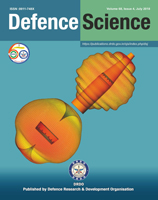Ultrasonic Standoff Photoacoustic Sensor for the Detection of Explosive and Hazardous Molecules
DOI:
https://doi.org/10.14429/dsj.68.12454Keywords:
Photoacoustic sensor, Ultrasonic photoacoustic spectroscopy, Quantum cascade laser, Standoff detectionAbstract
Standoff photoacoustic spectroscopic technique has been studied for the detection of hazardous molecules adsorbed on surfaces and in vapour/aerosols form in open air. Detection and identification of components in explosive mixtures in trace amounts is very challenging by any point or standoff spectroscopic detection technique. Discusses detection and identification of such components using standoff laser photoacoustic spectroscopic technique. Laser photoacoustic spectra of various trace molecules in the mid-infrared spectral band 7 μm - 9 μm have been recorded in vapor, aerosol, liquid forms as well as samples adsorbed on surfaces such as plastic and cloth. Pulsed quantum cascade laser is modulated at a frequency of 42 kHz resonant with that of microphone. Hazardous chemicals/explosives adsorbed on plastic and cloths surfaces were detected from a standoff distance up to 1.5 m. The sensitivities were found to be 20 μg/cm2, 20 μl liquid and 1.0 ppm corresponding to solid, liquid and vapour phases respectively. The chemicals/explosives used in the study were PETN, DNT, Acetone, and DMMP. Our study suggests that the photoacoustic technique has high selectivity and sensitivity for the trace detection and be used for screening of suspicious objects for security applications as a handy product.
References
C. W. Van Neste, L. R. Senesac, and T. Thundat, Standoff Spectroscopy of Surface
Adsorbed Chemicals, Analytical Chemistry 81 (5) ( 2009) 1952-1956.
C. W. Van Neste, L. R. Senesac, and T. Thundat, Standoff photoacoustic spectroscopy,
Applied Physics Letters 92 (2008) 234102.
Ramesh C. Sharma,Deepak Kumar, Neha Bhardwaj, Saurabh Gupta, Hukum Chandra,
Anil K. Maini, Portable detection system for standoff sensing of explosives and hazardous
materials, Optics Communications 309 (2013) 44-49.
B. Perrett, M. Harris, G. N. Pearson, D. V. Willetts, and M. C. Pitter, Remote
photoacoustic detection of liquid contamination of a surface, Appl. Opt. 42 (2003) 4901.
Xing Chen, Liwei Cheng, Dingkai Guo, Yordan Kostov, and Fow-Sen Choa, Quantum
cascade laser based standoff photoacoustic chemical detection, Optics Express 19 (21),
(2011) 20251-20257.
Chen Xing , Guo D, Choa FS, Wang CC, Trivedi S, Snyder AP, Ru G, Fan J., Standoff
photoacoustic detection of explosives using quantum cascade laser and an ultrasensitive
microphone, Applied Optics 52 (12) (2013) 2626-32.
Ramesh C. Sharma, Subodh Kumar, Saurabh Gupta, Hari B. Srivastava, “Photoacoustic sensor for trace detection of post-blast explosive and hazardous molecules”, Sensors and Actuators B: 243 (2017) 59-63.
Carmen M. Ramos, Liliana F. Alzate, Neiza M. Herna´ndez, Samuel P. Herna´ndez,
Nairmen Mina, Density functional theory treatment of the structures and vibrational
frequencies of 2,4- and 2,6-dinitrotoluenes, Journal of Molecular Structure: Theochem 769
(2006) 69–76.
Stewart, J.J.P., S.R. Bosco, W.R. Carper, Vibrational spectra of 2,4,6-trinitrotoluene and
its isotopically substituted analogues, Spectrochimica Acta Part A: Molecular Spectroscopy,
(1) (1986) 13-21.
S.V. Ingale, P.B. Wagh , P.U. Sastry , A.K. Patra , R. Tewari , I.K. Singh, S.B.
Phapale, R.D. Wasnik, A. Subhananda Rao, and Satish C. Gupta, Nanocrystalline
Pentaerythritoltetranitrate using Sol-Gel Process, Defence Science Journal, 61(6) (2011)
-539.
Yuri A. Gruzdkov and Yogendra M. Gupta, Vibrational Properties and Structure of
Pentaerythritol Tetranitrate, J. Phys. Chem. A 105 (2001) 6197-6202.
Yonggang Zhang, Zhenxing Cheng, Aizhen Li and Songlin Feng “Mid-infrared absorption spectra of dimethyl methylphosphonate as molecular simulant of nerve agents” CHINESE OPTICS LETTERS 4, 10, 2006.
Downloads
Published
How to Cite
Issue
Section
License
 Where otherwise noted, the Articles on this site are licensed under Creative Commons License: CC Attribution-Noncommercial-No Derivative Works 2.5 India
Where otherwise noted, the Articles on this site are licensed under Creative Commons License: CC Attribution-Noncommercial-No Derivative Works 2.5 India


